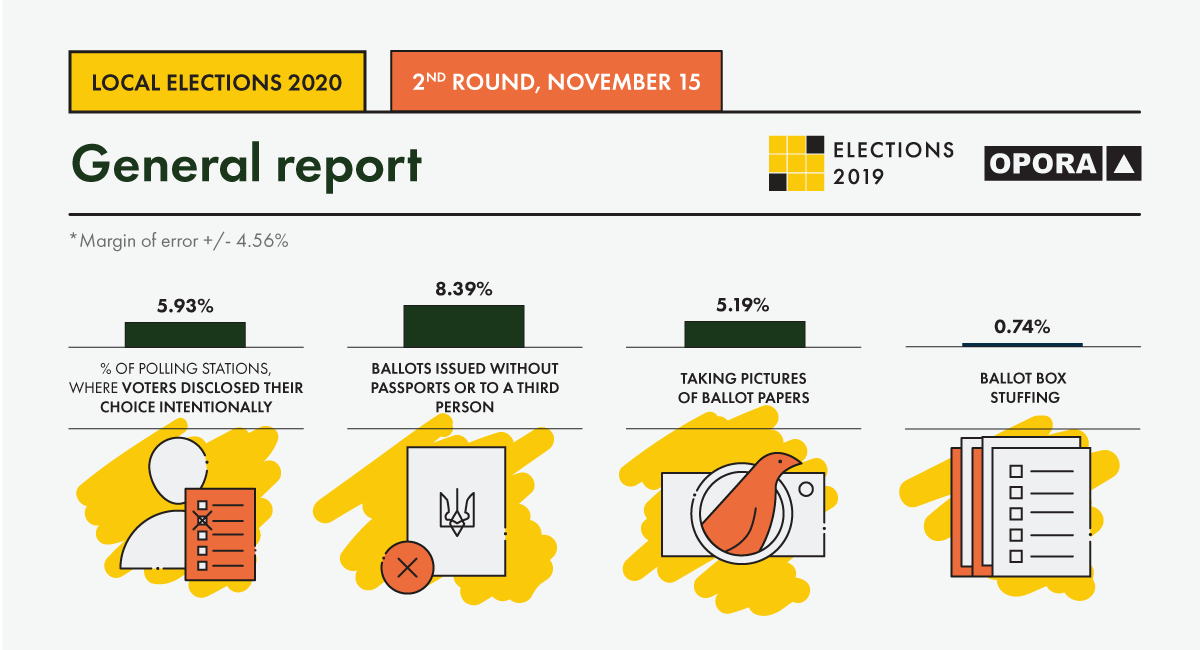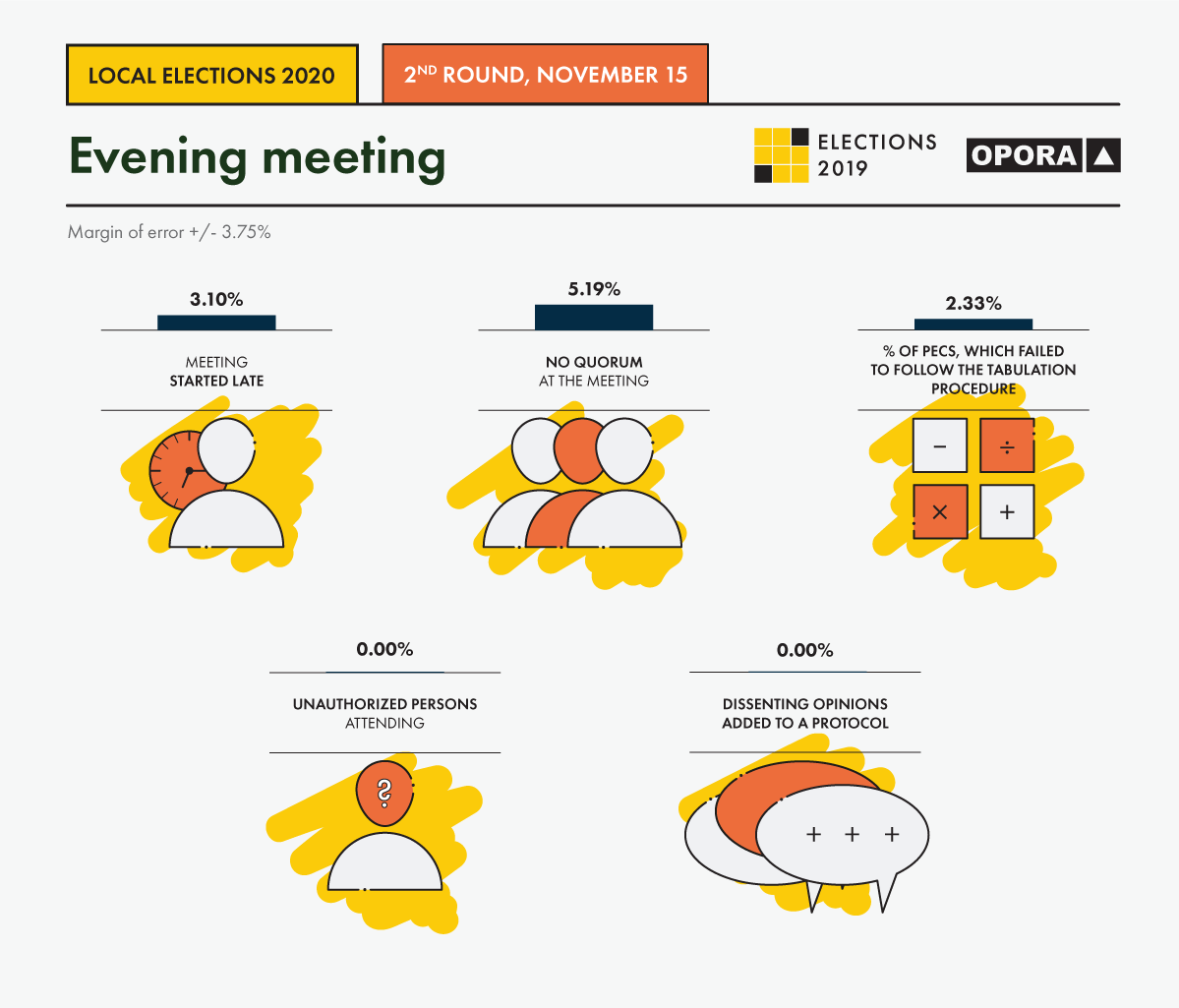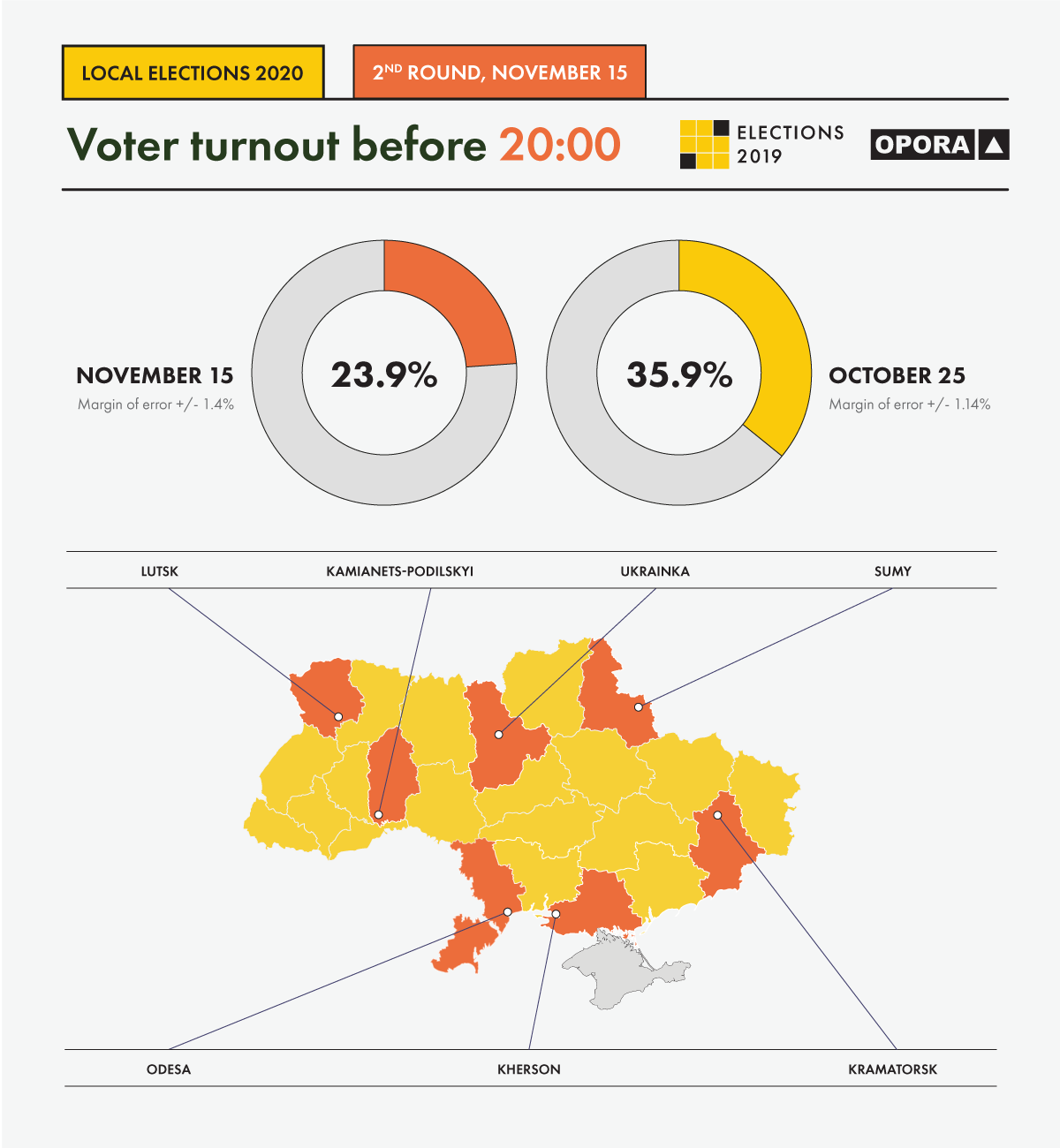Civil Network OPORA conducted independent non-partisan observation of the repeat mayoral election held on November 15, 2020 in Lutsk, Odessa, Sumy, Kherson, Kamianets-Podilsky of Khmelnytsky Oblast, Kramatorsk, and Ukrainka of Kyiv Oblast. In all localities, except Ukrainka, the rerun election was called because none of the candidates had won more than 50% of the votes cast during the October 25 election. Mayoral elections in the communities with 75,000+ voters are held under an absolute majority system. In Ukrainka, Kyiv Oblast, however, a repeat vote was scheduled because two candidates had received the same number of votes.
The Electoral Code establishes that rerun election shall take place within three weeks after the date of the decision on its call. The campaigns of the candidates participating in the rerun election (“second round”) were thus short, showing no gross violations of the law. In the run-up to the voting day, the candidates focused their campaigning on social media, with electioneering characterized by more extensive smearing of competitors. OPORA observers noted that some candidates in the rerun elections resorted to covert advertising on national television channels. Such practices resulted from the support of local candidates by national political leaders and highlighted the problem of unequal access of candidates to the media and lack of transparency of campaign financing. Therefore, there were no massive vote buying or other election fraud techniques during this short campaigning period, but the unequal access of candidates to the media and lack of accountability and transparency of election funding remain the challenges that should be addressed by the parliament to reform the law. The blurred division of the public administration duties and electoral interests of the candidates holding influential posts in the local governments remained an issue as well.
In the run-up to the repeat voting on November 15, the National Police of Ukraine and the Security Service of Ukraine reported detection and prevention of gross violations of the election law, which required further objective investigations.
OPORA recognized the active role the Central Election Commission played to inform voters about the specifics of the rerun election and respond promptly to various problems in the work of territorial election commissions. On the contrary, TECs’ work to arrange the repeat voting showed a number of organizational issues, in particular when ballots were delivered to precinct election commissions. Moreover, some TEC members were politically biased. Similar processes were observed in PECs that saw significant staff rotations. Conflicts and instability in the work of territorial and precinct election commissions require a broad discussion to introduce comprehensive reforms of the election administration system in Ukraine.
According to OPORA, the integrated turnout was 23.9% in seven Ukrainian cities and towns (with a 1.4% margin of error). The relevant integrated turnout had been 35.9% (a 1.4% margin of error) on the local election day on October 25, 2020 and 34% (a 1.1% margin of error) in the rerun mayoral election in 2014. The voter engagement and turnout were affected by the spread of COVID-19 in Ukraine and a varying election campaign intensity in different cities and towns. OPORA recommends that the central and local governments strengthen efforts to raise voters' awareness on the pandemic prevention measures taken during the elections. This would encourage voters to turn out.
Typical violations
On the repeat voting day, OPORA observers made a comprehensive assessment of the compliance with electoral laws and the quality of implementation of key election procedures at all stages of the election process, from preparatory meetings and polling station opening through the entire voting process, ballot count, and transportation of documents from precinct election commissions to territorial election commissions. OPORA observers conducted continuous observations in a representative number of polling stations throughout Ukraine, namely at 133 polling stations evenly distributed across the country where the rerun election took place. The observers were deployed on the basis of the stratified random sampling. Before starting its observations, OPORA conducted two rounds of training and special election day simulations for the observers to train them to respond to different situations and incidents. OPORA's statistically based observation is an independent practice undertaken only by OPORA with the intention to provide unbiased information about the elections.
The general statistical data of violations and abuses (by type) do not differ much from the figures recorded by OPORA observers in the October 25, 2020 elections. By the general assessment of the observers, no significant irregularities that could affect the election results were found at the polling stations during the rerun election. At the same time, 10% of polling stations (a 5.18% margin of error) had minor procedural violations by the end of the voting day. In the first round, such irregularities were found at 9.4% of polling stations hd (a 2.71% margin of error).
On the election day, the most common procedural violations included, among others, attempts by the precinct election commissions to hand out ballots to voters without their presenting proper ID documents, such as international passports. Such incidents were neither massive nor repetitive, but they were reported at 8.39% of polling stations throughout Ukraine (a 4.56% margin of error). The prevalence of such violations did not decrease significantly as compared to the first round (10.04% of polling stations), although some PEC members already had additional experience of election administration and the voting process was simplified. Where election participants tolerate situations in which voter identification for the ballot handout is based on informal communication and acquaintance between voters and commission members, rather than on the basis of Ukrainian passports, it encourages disregard for the law and irresponsible behavior of voters. It also bears the risk of deliberate attempts to falsify elections using such practices.
Violations of the secrecy of vote committed by photographing the ballot was yet another common problem recorded on the day of the second round of elections, as well as during the first round. Such violations were recorded at 5.19% of PECs (error 4.56%). Another violation involved voters voting outside the voting booths or openly showing their ballots. Such violations were recorded at 5.93% of PECs. The number of cases where ballots were photographed increased slightly compared to the first round of elections when this kind of violations was recorded at 1.6% of PECs. The danger of such violations is that they may indicate the use of controlled voting technologies (voter bribery), therefore they require special attention and response of the law enforcement agencies.
The problem of ballot manipulation during voting was much less pronounced. In particular, attempts to drop packs of ballots into ballot boxes were detected in 0.74% of polling stations (0.64% during the first round). Despite some high-profile incidents of improper ballot filling and forgery, these numbers are generally satisfactory as a high number of cases where ballots are cast in bulk may result in invalidation of voting at polling stations, thus affecting the election results in the conditions of a low turnout.

OPORA observers generally commended the processes of the preparatory sessions and the start of voting. At the time of the preparatory meeting and opening of the polling stations, official observers were able to observe the progress of all election procedures without hindrance at 97.71% of PECs. Some incidents that made it impossible for observers to fully record key procedures at this stage (including where they were not allowed to attend the meetings) occurred at 2.29% of PECs.
According to the observers, about 16% of PECs failed to meet the timing requirements for the preparatory meetings which must be open to the official observers and other actors in the election process. Also, at almost 10% of the polling stations, PEC members failed to ensure recording of the minutes of the meeting that, in particular, should include information on the preparation of the voting process. The vast majority of the polling stations (80.15%) opened on time at 8:00 a.m., while some 20% of PECs started voting before the statutory opening time.
In general, the voting in the final hours took place in a conflict-free environment and was arranged in a way that allowed voters to fully exercise their right to vote. The observers reported that 98.46% of PECs did not see any lines at the time of polling station closure, primarily due to low voter turnout and proper organization of the voting process.
OPORA observers also found that implementation of legal procedures at the stage of closing of the polling stations and vote counting complied with basic legal requirements and was properly organized.
According to the observers, PEC members violated the vote counting procedure at 2.33% of the polling stations, which is significantly less than in the first round of voting when such problems had been identified at 10.23% of PECs due to parallel application of several electoral systems.
Instead, the issue of authority of the precinct election commissions at the final meeting became more apparent in the second round. At 5.19% of PECs (a 3.75% margin of error) there was a lack of quorum at the tabulation meetings, which required prompt response from the commission managers. In the first round, 2.08% of PECs had had no quorum at the evening meetings. This time, the traditional problem of inadequate professional selection and staffing of election commissions was aggravated in view of the objective impact of the epidemic situation caused by the spread of COVID-19.
The observers also analyzed PECs' compliance with the law regarding the timely start of the final meeting (immediately after polling stations closed), which is an important condition for monitoring the entire tabulation process. This requirement was breached at 3.1% of polling stations, while 96.9% of PECs started the final meeting on time.

The observers identified no systemic problems or recurrent attempts to obstruct legitimate vote counting by candidates, party representatives, candidate proxies, or observers, although some conflicts were still reported by the observers.
Similarly, PEC members, according to the observers, did not exercise their right to add dissenting opinions to the vote tabulation minutes in the event of disagreement with the vote count results.
The situation with access to the vote tabulation minutes improved. At 96.9% of polling stations, OPORA observers received tabulation minutes, while the minutes were not received for various reasons at 3.1% of PECs. In the first round of elections, copies of the minutes had not been given to the observers at 8.09% of PECs.
Voter turnout (according to Civil Network OPORA)
On the day of the second round of voting, on November 15, 2020, Civil Network OPORA assessed the voter turnout on the basis of a national-level statistically representative sample of the polling stations where official observers of the organization were deployed. The data was recorded at 12:00, 16:00 and 20:00.
According to OPORA observers, during the second round of voting on November 15, the integrated voter turnout in seven cities was 23.9% (a 1.4% margin of error) at 20:00. In comparison, the 8 pm turnout was 35.9% across Ukraine during the voting on October 25.

Preliminary results of verification of the detected violations
OPORA observers identified and verified 96 violations of electoral law and democratic election standards after the opening of the PECs on the election day. In particular, 22 out of 96 identified violations were related to inadequately equipped polling stations, breaching the requirements established by the Electoral Code, CEC resolutions and the Government Regulations for Anti-Epidemiological Measures during Voting. At some polling stations, the observers faced obstruction of their legitimate activities by election commission members (7 incidents). Issuing ballots by one PEC member instead of two, as required by the Electoral Code, was a common practice (13 incidents). Particular attention should be paid to the incidents with elements of controlled voting (3 incidents) and voters taking pictures of their ballots (6); voting for another person or without proper documents (4); obstruction of voters by other observers (1); and violation of the vote counting procedure at the polling station (5).
PECs often committed procedural violations, such as where election commission members did not keep minutes of the preparatory meeting (7 incidents). Members of certain PECs also resorted to overbilling (entering one more day of vote counting to the tabulation minutes in order to increase the amount of compensation for their work) (5 identified incidents).
Detailed information about these and other incidents can be found on the official website of the OPORA Civic Network.
